If you are traveling to find dramatic mountain ranges, breathtaking fiords and beautiful alpine lakes, look no farther than New Zealand’s South Island. While the North Island has its own impressive and varied landscapes and activities, New Zealand’s South Island has some of the most striking scenery in the country.
Many people will say that a trip to New Zealand isn’t complete without visiting the South Island. Of course, that’s not entirely true. But you will be missing out if you travel all the way to the bottom of the world and don’t see some of the gems found in this part of the country.
I spent about two weeks in the South Island during my one-month campervan trip around New Zealand. Honestly, I could have taken more time as there’s just so much to see! Plus, the weather and seasonal closures got in the way sometimes.
In this post, I’ll share my list of key places to visit on New Zealand’s South Island, places I regret visiting and places I wish I’d visited.
Read more about my recommendations for key places to visit on New Zealand’s South Island and decide for yourself.
Table of Contents:
- Recommended Places to Visit
- Places I do not Recommend
- Other Places to Consider
- Potential Itineraries
Recommendations for Places to Visit on New Zealand’s South Island
Marlborough:
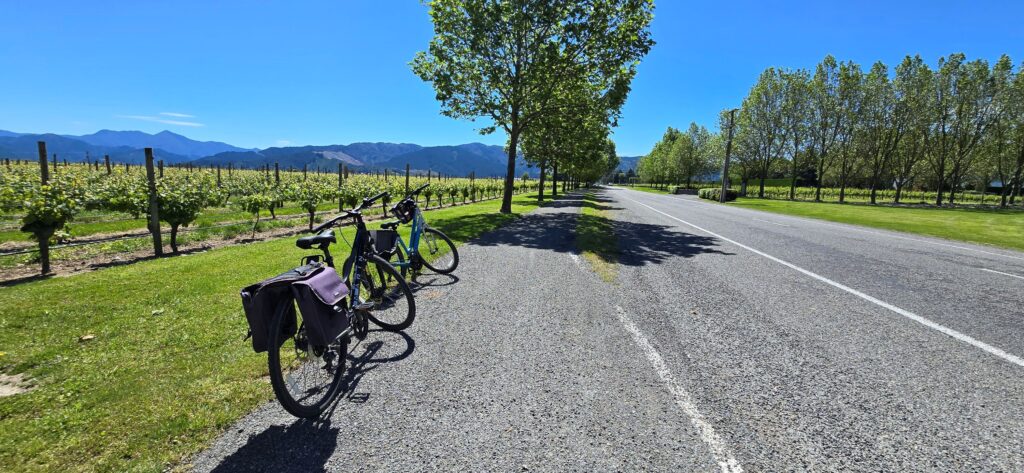
Marlborough is probably New Zealand’s most popular wine region. Certainly, it’s the most famous on New Zealand’s South Island. Of the four wine regions I visited throughout the country, I’ve got to say Marlborough is the prettiest. Wine is good, too – though there is less variety than you’d find on the North Island due to climate.
If you really want to visit one of New Zealand’s wine regions and only have time for one, I’d definitely recommend Marlborough. The vineyards with the backdrop of the mountains just make it a very nice place to spend a day.
If you visit Marlborough, I highly recommend renting a bike to see the region. There are some nice bike paths around the wineries, and it’s a great way to take in your surroundings. It’s also more responsible than driving, easier than walking and more economical and fun than a bus tour.
If you can’t make it to Marlborough, Otago is also a nice wine region closer to Christchurch. The scenery isn’t quite as stunning, but the wine is just as good (or better).
Abel Tasman National Park:

Abel Tasman National Park is a jewel on New Zealand’s South Island. It’s located on the northwest coast of the island and is known for its gorgeous coastline.
This park is perfect for hiking, swimming and kayaking. In fact, it’s home to one of New Zealand’s Great Walks – the Abel Tasman Coastal Track. You can do the full walk over about three to five days. Or you can do just part of the walk in a day hike.
Note that you can easily drive to the trailhead to do just part of the track. This trail is an out-and-back to yellow point that takes you through a beautiful part of the Coastal Track. You can also pay $80 NZD to take the water taxi out to a separate area of the park that has one of the most beautiful sections of the trail. I thought the area I hiked for free was beautiful enough, though.
You can also visit just to kayak or hang out at the beach. It’s a good place for any coastal lovers!
Pancake Rocks:
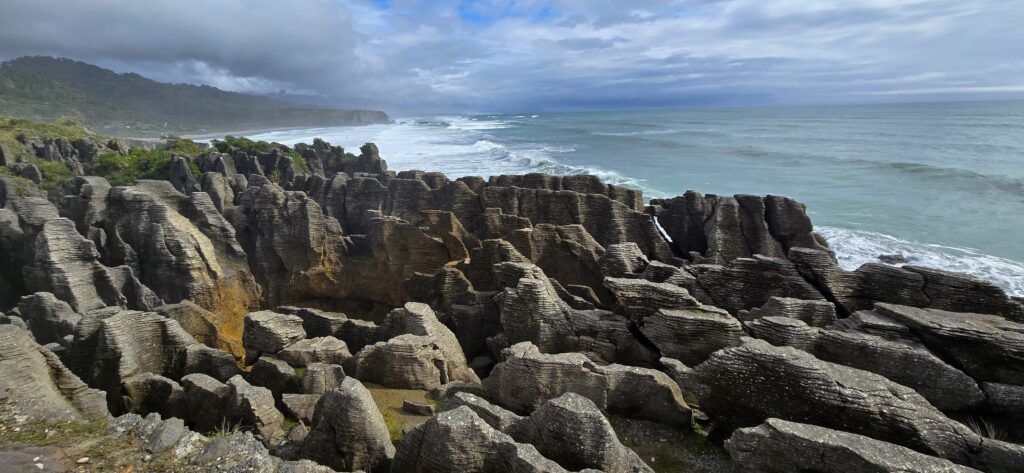
The pancake rocks of Punakaiki are a natural phenomenon you must see on New Zealand’s South Island if you’re interested in unique rock formations.
The rocks got their name because they look like very tall stacks of endless pancakes jutting up out of the sea. They were naturally formed by a combination of erosion and tiny animal skeletons.
When you arrive in Punakaiki, you’ll see signs directing you to the walking path for the rocks. An easy 30-minute walk over the sea cliffs will give you amazing views of the rock formations and give you a good understanding of how incredibly powerful the ocean is to have shaped them over time.
Lakes Tekapo & Pukaki:
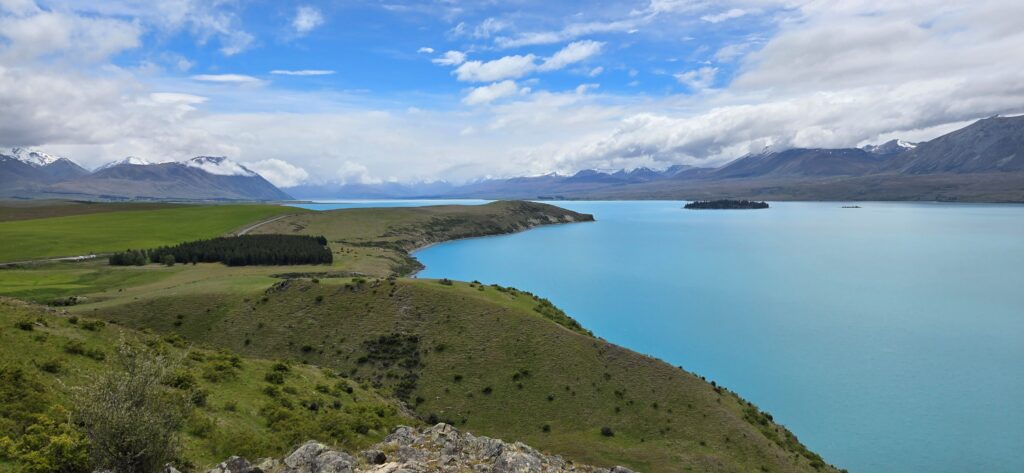
Tekapo and Pukaki are two alpine lakes near Aoraki/Mount Cook National Park and both are worth a visit. You can easily visit both in one day, perhaps even paired with a hike to see Aoraki/Mount cook up close if you’re really pressed for time.
The best way to enjoy Lake Pukaki is to drive along the perimeter of the lake and pull out at viewpoints. You’ll get the best views on a nice clear day. On a really clear day, you may get to see the full outline of the Southern Alps, Aoraki/Mount Cook as the crown jewel. If you’re traveling New Zealand in a campervan, there is a freedom campsite along the lake that offer these incredible views.
Of the two lakes, I believe Tekapo is the more popular. I can understand why – Tekapo has these deep turquoise waters, ringed by snowcapped mountains. I recommend doing a full hike above Tekapo to escape the crowds the tour buses bring in, and for better views.
Fox & Franz Josef Glaciers:
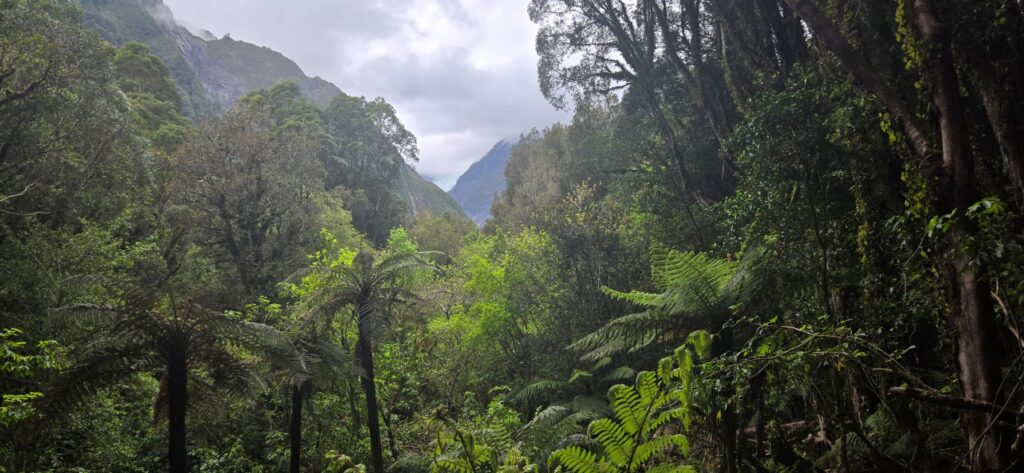
Fox & Franz Josef Glaciers are the most popular glaciers to visit in New Zealand. Both are easily accessible by short hikes and are large enough to see from a distance. They are about an hour apart by car.
For both glaciers, you can choose your level of hike difficulty to see them. Franz Josef has an easy 20-minute hike that takes you almost as close as you can get to the glacier. Tourists used to be able to walk into the valley for an even closer look, but that part is now roped off. Unfortunately, the day I visited was too cloudy to see the glacier. However, I did learn about how climate change was affecting it. Franz Josef also has a hike that’s a harder difficulty and gives you a somewhat better viewing opportunity. But for most, the easier path is fine.
Fox Glacier has a few trails of varying difficulty. There is an easy path, similar to Franz Josef that gets you to a glacier viewing platform. There’s also a medium-difficulty path that takes about 1.5-2 hours roundtrip and gives two points from which you can see the glacier. The hike is primarily through a rainforest. I thought it was very cool that I was walking through a rainforest to see a glacier. Ordinarily, I’d expect a very different climate and ecosystem for glacier viewing.
If you only have time for one glacier, I enjoyed Fox Glacier more. Of course, I was actually able to see part of it despite the cloudy day.
Aoraki/Mount Cook National Park (Hooker Valley Track):
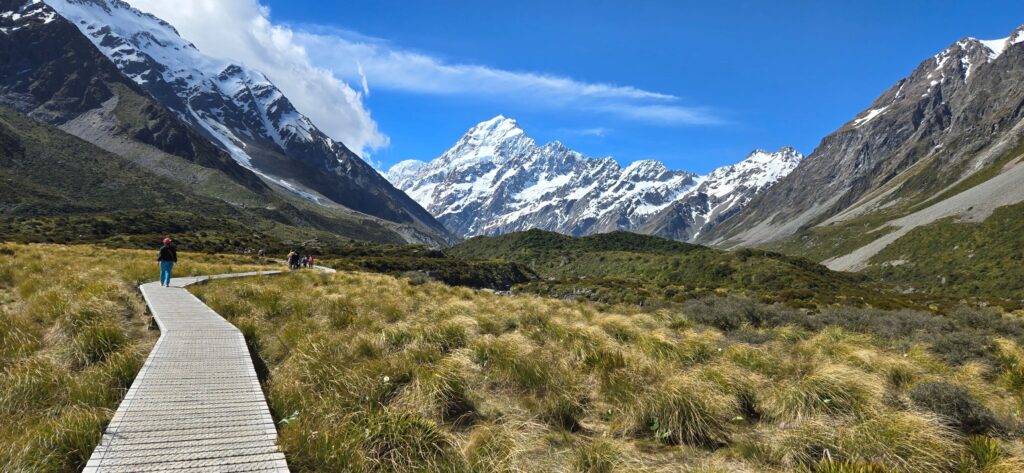
If I had to choose one experience anyone visiting New Zealand absolutely had to do, it would be this hike to Hooker Lake via the Hooker Valley Track in Aoraki/Mount Cook National Park.
While I usually prefer more challenging hikes, this track has the best reward-to-effort ratio I’ve ever experienced. It’s a mostly flat seven-mile out-and-back trail that immediately wows you with dramatic views of the Southern Alps and just gets better over the course of the hike. Seriously, you start having your breath taken away about five minutes into the hike – and not due to the hike’s difficulty as it’s more like a nature walk.
You won’t get bored of the views for the entire trail. At the end, you’ll come to Hooker Lake, with Aoraki/Mount Cook towering over it. There were even small icebergs still in the lake during my hike in late spring.
Aoraki is one of the most sacred mountains in New Zealand for the Māori, and it also has information about it along the trail. The legend of Aoraki is that three brothers went out in a canoe, but got caught on a reef. The tallest brother, Aoriaki, climbed to the top of the canoe for help and froze there in the southern winds. Frozen in time, Aoraki became the mountain, his brothers the Southern Alps, and the canoe became the South Island.
If you can make it happen, definitely hike this trail on a very clear day. The hike is incredibly popular and gets insanely crowded between 10-3. I recommend starting early in the day before 9 or later in the day after 4, if possible, to try to avoid the crowds.
Timaru:
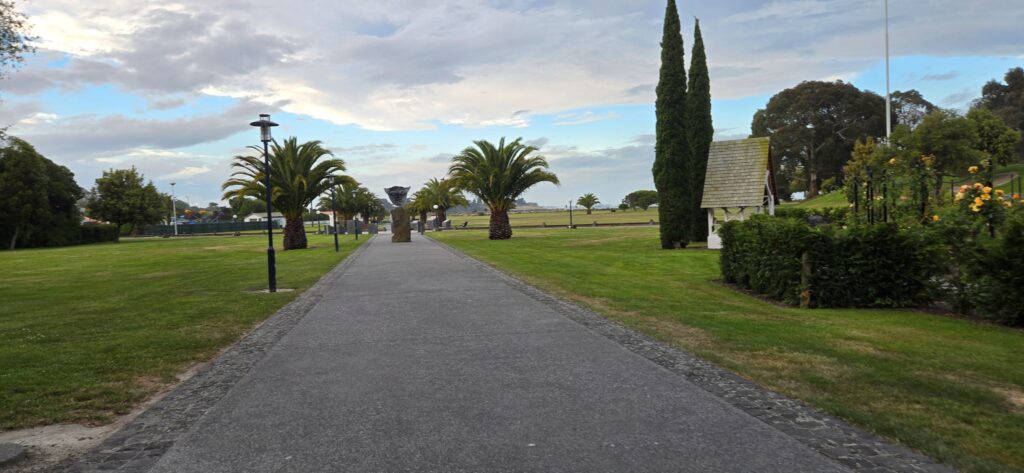
Timaru is a small town on the east coast of the South Island. If you ask Kiwis the best thing to do in Timaru, they’ll say “leave,” but the reason to visit is not necessarily for the town itself. The reason is for the little blue penguins.
Little blue penguins are the smallest species of penguin in the world and native to New Zealand. At full height, they average about one foot (~30 cm) or so tall. In Timaru, you can watch them march on their daily commute to/from sea to get fish to feed their chicks.
If you’re visiting at dusk, I recommend getting to the penguin spot about an hour before sunset. When you get to the beach, you’ll see signs along the sidewalk pointing you towards the penguin viewing area – you can’t miss it. You have to watch them from the viewing area above the beach. Authorities will begin asking people to leave the beach as the typical time of the penguins’ arrival approaches. If the penguins start arriving and see people in front of their nests, they could get scared off and run away, causing their chicks to starve.
The penguin security is present along the viewing platform as well to ensure everyone is respectful, and the penguins are safe. They also are available to help answer questions and educate people about the penguins.
The penguins can take hours to arrive, so patience is key.
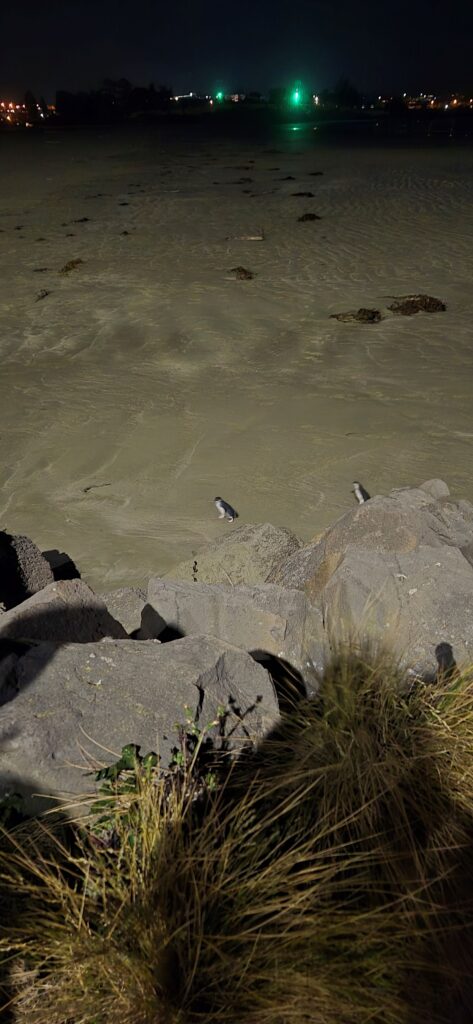
We spent about three hours watching as penguin groups trickled in and waddled up the beach to their nests.
If you’re traveling New Zealand in a self-contained campervan, there is a freedom campsite about a five-minute walk from the penguin viewing area. Timaru also has a pretty cool bar to visit called Hector Black’s if you’re looking for a drink or interesting vibe before or after your penguin viewing party.
Lake Wānaka:

Lake Wānaka is a beautiful alpine lake surrounded on one side by a mountain range and on the other side by the town of Wānaka. You can spend a little bit strolling the shores of the lake. The most famous thing to see at Lake Wānaka is #ThatWānakaTree.
The Wānaka Tree is a unique willow tree known for its ability to grow in the middle of the lake. It’s a sight to behold, surrounded by water and framed by snow-capped mountains.
Near Lake Wānaka, you can also find great hikes. Perhaps the most famous nearby hike is Roy’s Peak, which is considered one of the best hikes on the South Island. Unfortunately, Roy’s Peak was closed for lambing season when I visited (October 1 to November 10), so I had to find an alternative.
The alternative was one of my favorite hikes in New Zealand, so I’m not sure how much better Roy’s Peak could be. The hike I did was called Diamond Lake to Rocky Mountain Peak. I did the hike backwards, and it was beautiful. This direction, you can see the views out over Lake Wānaka for the majority of the hike to the top. At the peak, you have panoramic views of the mountains and lakes.
AllTrails rates this hike as challenging, but I honestly didn’t find it too bad. There are some steep sections, but nothing to worry much about. The hardest part is climbing down the waterfall on the descent.
Queenstown:
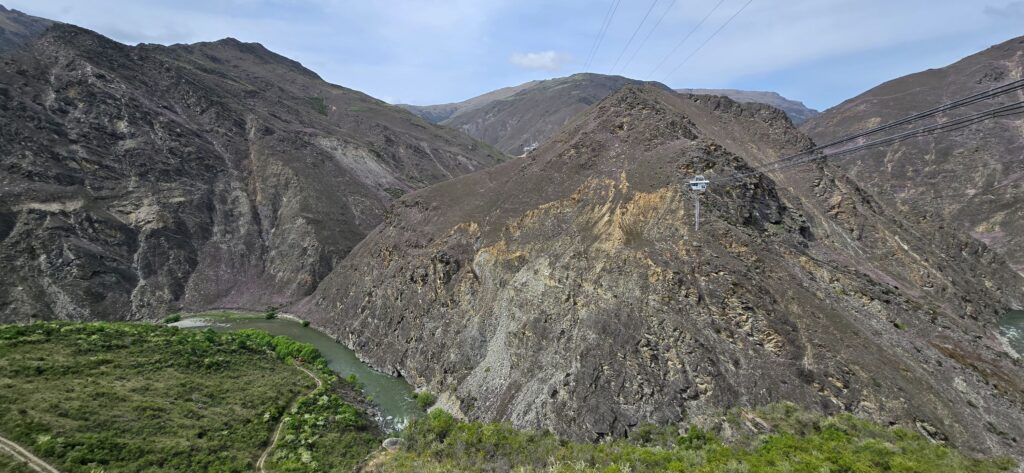
Queenstown is a beautiful city known as the adventure capital of New Zealand (some say of the world). This city is the place to visit if you’re looking to get a good adrenaline rush.
In Queenstown, you can jump from New Zealand’s highest bungee platform (one of the top-20 highest in the world), swing over a canyon in the world’s highest swing, sky dive, paraglide or do a number of other extreme adventure activities.
Queenstown has a couple of interesting hikes you can do as well. Crown Range Summit above is said to give visitors a 360 view of Middle Earth. The Queenstown Hill Walkway and Ben Lomond Tracks are also said to be interesting hikes in/near the city.
Queenstown is also the gateway to other interesting places to visit in New Zealand. From here, you can head up to Glenorchy and Paradise and get great mountain views. There are some Lord of the Rings filming locations on the drive to paradise, including Lothlorien and Ithilien Camp. The city is also a good base for exploring Wānaka, and group trips to the Fiordlands.
Fiordland National Park:
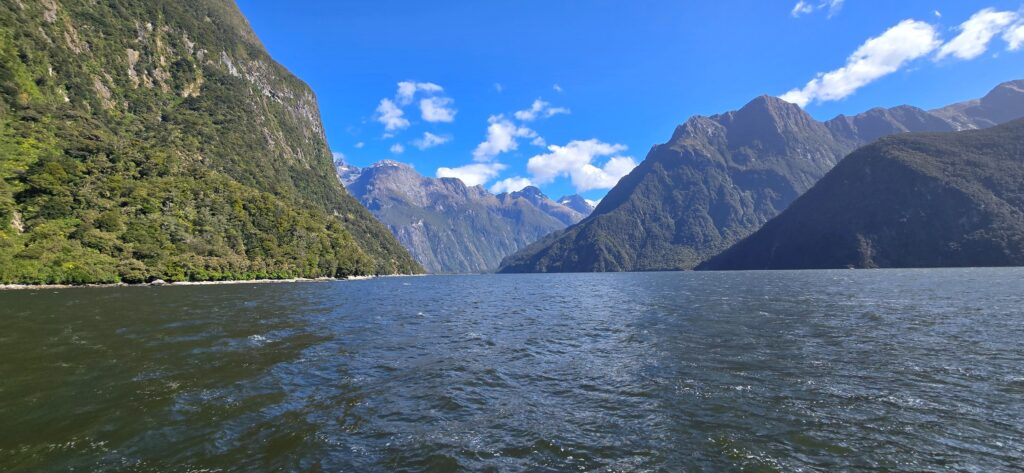
If you’re on New Zealand’s South Island for dramatic mountain views, it really doesn’t get any better than Fiordland National Park. The drive into this park has some of the most epic views of any drive in the country. As you’re heading into the park, you’ll be surrounded by gigantic mountains, cascading waterfalls and tons of amazing lookout points.
Fiordland National Park is also home to one of the Wonders of the Natural World, Milford Sound. Plus its larger, lesser-known sister, Doubtful Sound.
You can visit Milford or Doubtful Sound on day or overnight cruises. You can also hike through Milford Sound on another of New Zealand’s Great Walks – the Milford Track.
The most common way to visit Milford Sound is on a two-hour nature cruise. You’ll float through the sound and learn about its geography while also looking out for marine life like seals, southern bottlenose dolphins and the Fiordland penguin.
You can visit Milford Sound on a group tour leaving from Queenstown or Te Anau. All the major cruise lines offer pickups from those towns. If you have your own transportation, I recommend self driving to Fiordland. You should book a cruise that either leaves in the morning or at the end of the day – that way you’re more likely to avoid the large tour bus groups and have a smaller crowd.
If you want to do some hiking in the Fiordlands, this national park is home to another of New Zealand’s Great Walks, the Routeburn Track. You can hike the Routeburn Track from hut to hut over 2-4 days. If you only have a day, you can just hike up to Key Summit and back for what are said to be incredible views on a clear day.
Slope Point:
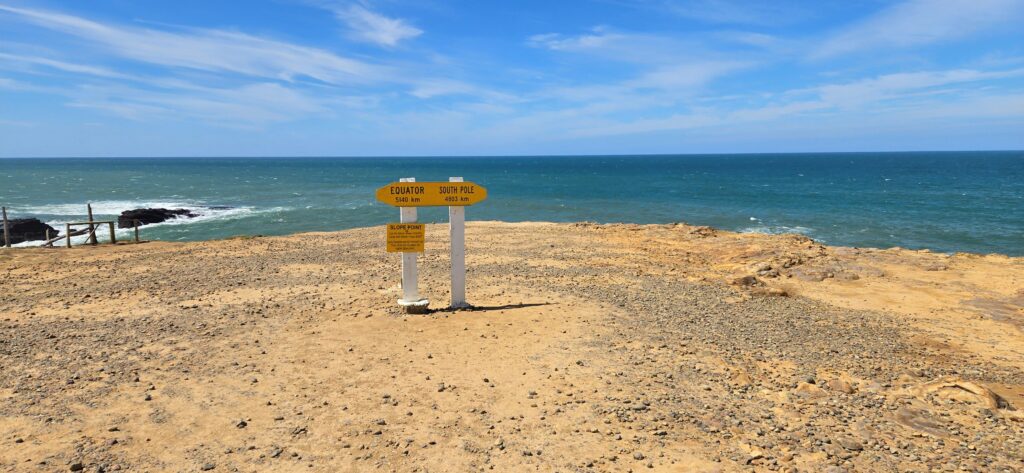
If you want to say you’ve visited the southernmost point on New Zealand’s South Island, you have to make it to Slope Point.
Slope Point is at the edge of the privately-owned Antarctic View Farms, marked by a lighthouse and a sign pointing to Antarctica. From the farm’s parking lot, it is about a 20-minute walk to the official southernmost point. Here you can admire the sea cliffs and try to spot a seal.
Small warning that Slope Point is very cold, even in late spring. Be sure to wear warm clothes.
Nugget Point:
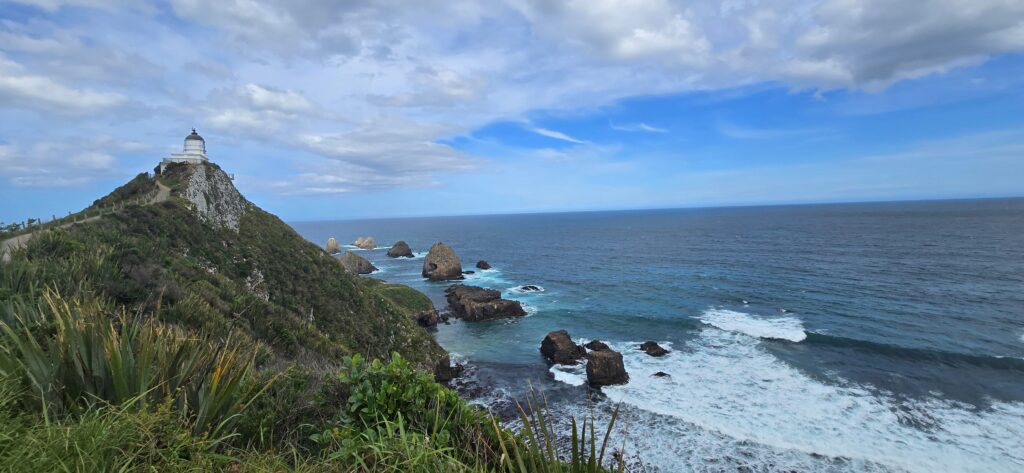
One of the most beautiful sea views I saw on New Zealand’s South Island – and there’s a lot of competition – is Nugget Point. This area has incredible natural rock formations (the “nuggets”) jutting up out of the sea. You can see them from the high sea cliffs.
To reach Nugget Point, you follow the Nuggets Road along the beach and up the cliffs. Keep your eyes peeled at the beach for seals and sea lions because they’re very common here! Once you reach the parking lot, there is a walk up to the lighthouse that takes about 45 minutes round-trip. As you walk to the lighthouse, keep looking out for seals and seal pups in the water below! The lighthouse is where you’ll see the nuggets.
If you’re at Nugget Point around dusk, stop by the penguin observatory for a chance to see the very rare yellow-eyed penguins. Be sure to keep noise to a minimum and watch them only from the observatory to avoid scaring them away.
Places I Don’t Recommend Visiting on New Zealand’s South Island
In addition to the key places I recommend visiting on New Zealand’s South Island, there are some places I wouldn’t necessarily recommend. They might be worth stopping by if they’re along your route, but I didn’t find them worth going out of my way to see.
Arthur’s Pass National Park:
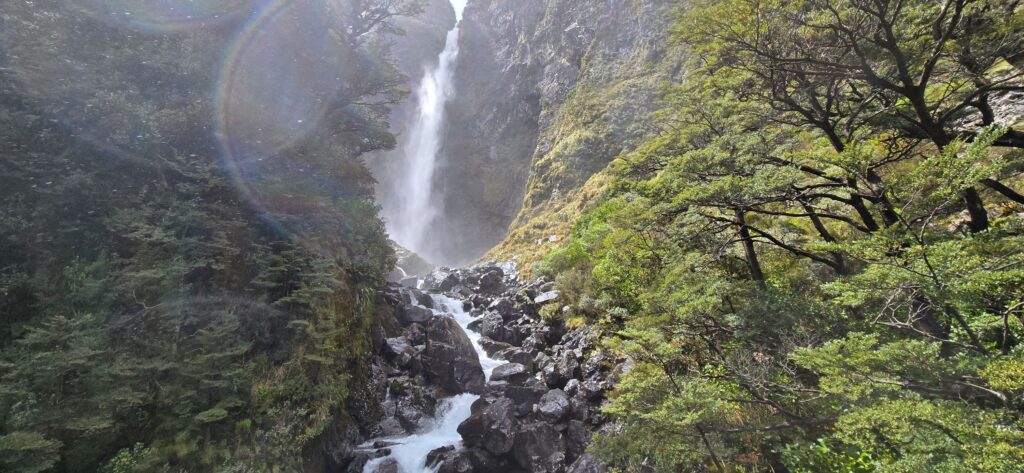
Perhaps this is an unfair addition to this list because I visited in pretty bad weather, but I was somewhat underwhelmed with Arthur’s Pass National Park. We hiked up to Devil’s Punchbowl, which is an impressive waterfall to be sure. But we’d seen other impressive waterfalls in New Zealand, so this one didn’t really seem worth a detour.
Overall, this national park just didn’t appear to offer anything more than other parks we’d visited in New Zealand. Perhaps in nicer weather when more hikes were accessible, it would have been more worthwhile. But for what we saw of the park, it wasn’t really worth going out of our way.
However, if you’re driving through Arthur’s Pass National Park on your route, definitely hike up to Devil’s Punchbowl. It doesn’t take long.
Christchurch:
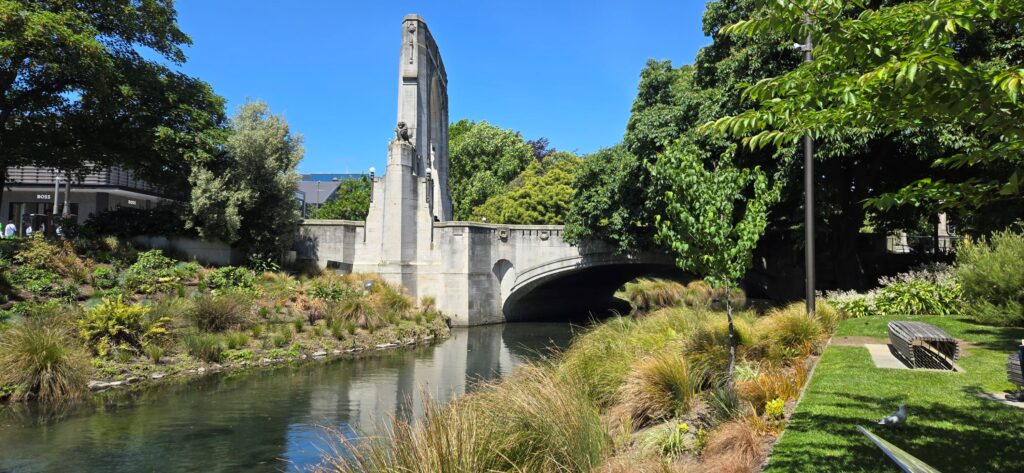
Christchurch might be New Zealand’s second most populous city, but it just doesn’t have as much to offer as cities like Auckland and Wellington. The majority of things I found recommended to do in Christchurch were things that were actually outside of Christchurch.
Of course, it’s not the city’s fault. In 2010 and 2011, Christchurch was hit with a series of devastating earthquakes that really badly impacted the city, and they’re still rebuilding. Unless you’re flying in or out of Christchurch, I think it can be skipped.
However, that did make it the perfect place to unwind for a few days after living out of a campervan for a month!
Moeraki Boulders Beach:
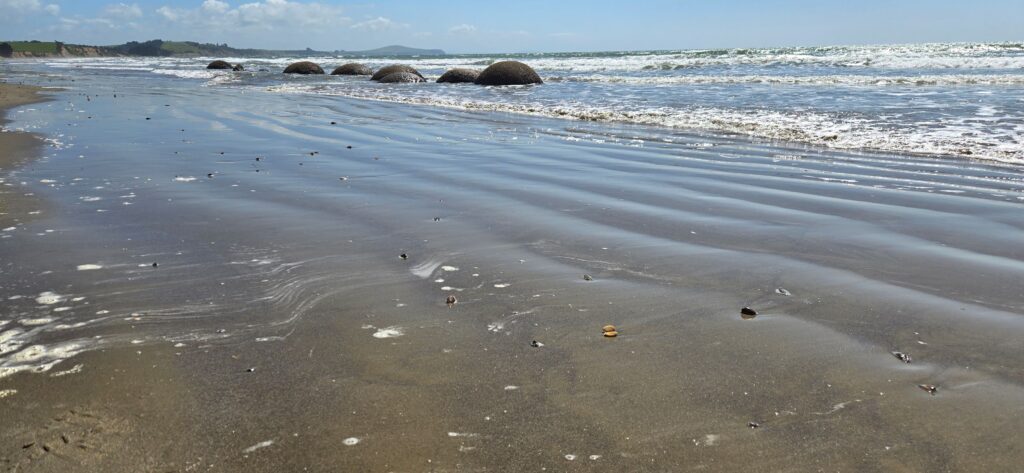
Perhaps the most disappointing place we went in New Zealand after the Waitomo Glow Worm Caves was this beach. In pictures, the boulders look huge, and it certainly is impressive that the sea and geological faults formed such naturally smooth rocks. But the boulders were just honestly not that impressive in person, and the beach was crowded.
Further, there were a ton of people standing on them for pictures when signs explicitly stay not to stand on them because doing so could damage them.
Supposedly, the Moeraki Boulders were more impressive years ago when they were more exposed, and they’ve gotten more buried in the sand over time. Today, they just kind of look like smooth lumps in the sand, and I’d say there’s little redeemable about visiting them.
Other Considerations for Place to Visit on New Zealand’s South Island
Although I spent a month in New Zealand, there were still a few places I wanted to see that I didn’t get to visit. Here are some additional places to consider visiting on New Zealand’s South Island:
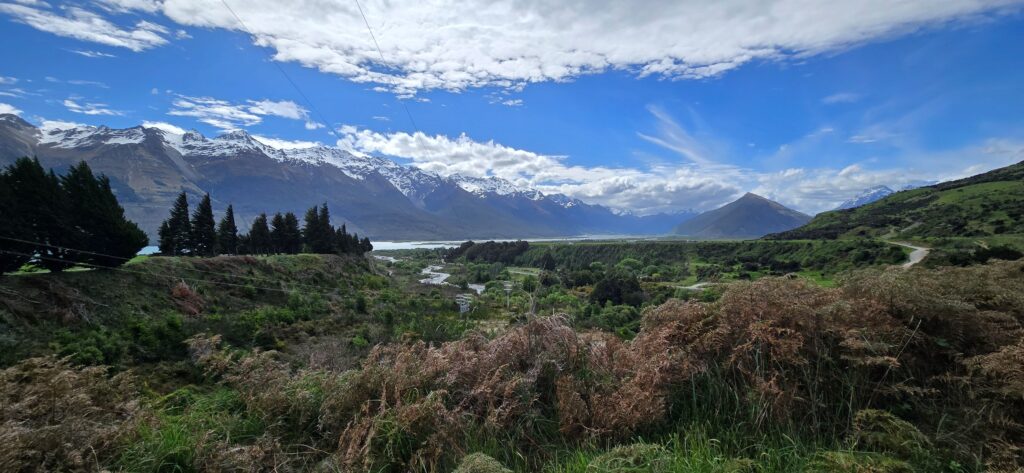
Kaikoura:
Kaikoura is in the northeast area of New Zealand’s South Island, between Marlborough and Christchurch. It’s known for having great whale watching tours and seal spotting, and supposedly really good seafood barbecue.
During New Zealand’s fall, you can usually find little seal pups scampering around. This time of year is when the pups and their mothers come to Kaikoura, and the pups learn to play. If we’d visited in fall, we’d have definitely made sure to make it to Kaikoura.
Mount Owen:
Just below Abel Tasman National Park, you can find Mount Owen, also known as the filming location for Dimrill Dale in the Lord of the Rings. Hiking to Mount Owen’s summit is meant to be challenging but with incredible views as a reward. It’s also a less popular hike on New Zealand’s South Island, meaning the trail is less crowded than you’d find elsewhere. Unfortunately, the weather wasn’t cooperating on the day we wanted to hike Mount Owen and had to give it a pass.
Mount Sunday:
Mount Sunday is another Lord of the Rings filming location with what are said to be beautiful views. This location was where they filmed scenes for Edoras. Hiking to the top of Mount Sunday is supposed to be pretty easy and only take a couple of hours. Unfortunately, this hike was another one we couldn’t accomplish due to weather.
Mount Aspiring National Park:
Mount Aspiring National Park is in the southwest of New Zealand’s South Island and is supposed to have a lot of beautiful hikes. I have to assume it got its name from making people aspire to be a hiker (don’t quote me on it, though).
Unfortunately, this park was another area we had to mostly skip due to weather and closures. One of its most popular hikes is the Blue Pools Track, known for its beautiful blue waters. It also has the Rob Roy Glacier Track that takes hikers through dramatic glacial landscapes.
Royal Albatross Centre:
Located in Harington Point, just outside of Dunedin is a natural albatross sanctuary. You can visit the observation area on a guided tour to hopefully see albatrosses and potentially the rare yellow-eyed penguins.
It’s recommended to visit the centre near dusk for the best opportunity to view flight and see the penguins. Because it is a natural sanctuary, there are no guarantees to see any animals. The tour is also focused on education about the albatross.
Tunnel Beach:
Tunnel Beach is on the southeast of the New Zealand’s South Island and is supposed to have beautiful sea cliffs and incredible rock formations naturally shaped by the sea. During low tide, you can do the Tunnel Beach walk to see the formations up close.
Tunnel Beach was closed due to heavy rain damage when we visited, so we couldn’t even see it from afar. Make sure to do your research to see if it’s open before driving over there.
Rakiura Track:
Technically, the Rakiura Track is on Stewart Island (Rakiura in Māori), but I’m including it here because it’s right below New Zealand’s South Island. You can get there with a small plane from a nearby town on the South Island, or via ferry.
Rakiura Track is considered another of New Zealand’s Great Walks and covers a good portion of this small island. It’s supposed to be one of the beautiful and least crowded hikes. We just didn’t have time for it when visiting.
Rakaia Gorge:
In the Canterbury region of New Zealand’s South Island, not far from Christchurch, you’ll find Rakaia Gorge. It’s a deep gorge filled with opaque blue water and framed by snow capped mountains. At least, that’s what it looks like in the photos!
There are popular hikes to do to see the gorge. We didn’t get around to it, but I’ve heard it’s beautiful.
Hokitika Gorge:
Hokitika Gorge and its Scenic Reserve are beautiful natural sites near the west coast of New Zealand’s South Island. There are nature trails through the reserve that are said to offer stunning views of the gorge. Unfortunately, bad weather caused us to skip this one, too!
Potential New Zealand South Island Routes for your Campervan Trip
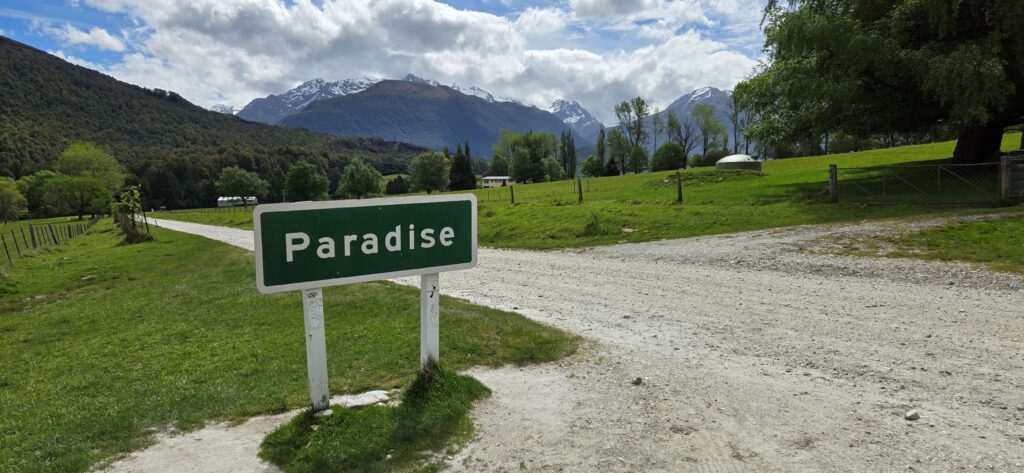
I know the route for a New Zealand Campervan trip can look very different depending on the amount of time you have. Here are some recommended routes for a New Zealand campervan or regular road trip for different lengths of time.
Note that these routes assume perfect weather your entire trip and no closures for different areas and tracks. That’s not entirely realistic, so you may have to rearrange or skip some things based on these obstacles. Always check the weather and check to ensure things are open!
These routes are all round-trip starting and ending in Christchurch and cover places to visit on New Zealand’s South Island only. If you’re planning a one-way trip or want to combine this route with a North Island road trip, check out this post.
Potential Route for a 7-Day New Zealand South Island Trip (round trip)
Here is a potential 7-day round-trip campervan route for the New Zealand’s South Island:
Day 0: Arrival
- Arrive in Christchurch, pick up campervan or car rental
- Drive to Lake Pukaki, overnight in lakeside campsite
1: Aoraki/Mount Cook & Lake Tekapo
- Wake up early to hike the Hooker Lake via Hooker Valley Track trail
- After lunch, hike one of the trails around Lake Tekapo
- Overnight between Lake Tekapo and Wānaka
2: Wānaka
- Drive to Wānaka
- Hike Diamond Lake to Rocky Mountain Peak trail
- Visit #ThatWānakaTree
- Overnight in Queenstown
3: Queenstown
- Visit Queenstown, choose two options::
- Explore Queenstown parks and restaurants
- Adventure activities like bungee jumping, adventure parks, paragliding, canyon swing
- Visit Glenorchy and Paradise for Lord of the Rings filming locations
- Hike Crown Range Summit
- Drive to Te Anau
- Overnight in or near Te Anau
4: Fiordlands National Park
- Drive to Fiordland National Park
- Milford Sound Cruise
- Drive to Catlins region
- Overnight in Catlins
5: The Catlins
- Visit coastal points of interest in southeast, such as:
- Monkey Island
- Slope Point (the southernmost point of the South Island)
- Curio Bay (petrified rock forest)
- Cathedral Caves
- Tunnel Beach
- Nugget Point
- Overnight between Catlins and Dunedin
6: Dunedin
- Drive to Dunedin
- Explore the city
- Drive to Royal Albatross Centre, taking your time along the peninsula
- Guided tour of Royal Albatross Centre around dusk
- Overnight near Dunedin
7: Otago Wine Region
- Optional: Drive to Timaru around dawn to see the little blue penguins
- Drive to Otago
- Self-guided hike or bike ride through winery trail
- Overnight in Otago
Departure Day
- Clean and return rental car or van in Christchurch
- Fly out of Christchurch
Potential Route for a 14-Day New Zealand South Island Trip (round trip)
Here is a potential 14-day round-trip campervan route for the New Zealand’s South Island:
Day 0: Arrival
- Arrive in Christchurch, pick up campervan or car rental
- Overnight between Christchurch and Kaikoura
1: Kaikoura
- Visit Kaikoura, option of:
- Coastal walks
- Marine life spotting
- Ethical dolphin/whale watching tours
- Drive to Marlborough
- Overnight in Marlborough
2: Marlborough
- Drive to Marlborough
- Self-guided bike tour of Marlborough wineries
- Overnight in Marlborough
3: Abel Tasman National Park
- Drive to Abel Tasman National Park
- Hike part of Abel Tasman Coastal Track (such as the trail to Yellow Point)
- Overnight in or near Abel Tasman National Park
4: Punakaiki Pancake Rocks & Hokitika Gorge
- Drive to Punakaiki
- Walk the Pancake Rocks track
- Drive to Hokitika Gorge
- Walk short trails around the gorge
- Overnight between Hokitika and Franz Josef Glacier
5: Franz Josef & Fox Glaciers
- Drive to Franz Josef Glacier
- Walk the short track to see Franz Josef Glacier
- Drive to Fox Glacier
- Walk the short track to Fox Glacier
- Overnight between Fox Glacier and Mount Aspiring National Park
6: Mount Aspiring National Park
- Drive to Mount Aspiring National Park
- Hike one or more of the trails such as:
- Blue Pools Track
- Rob Roy Glacier Track
- Overnight in Wānaka
7: Wānaka
- Drive to Wānaka
- Hike Diamond Lake to Rocky Mountain Peak trail or Roy’s Peak
- Visit #ThatWānakaTree
- Overnight in Queenstown
8: Queenstown
- Visit Queenstown, choose two options::
- Explore Queenstown parks and restaurants
- Adventure activities like bungee jumping, adventure parks, paragliding, canyon swing
- Visit Glenorchy and Paradise for Lord of the Rings filming locations
- Hike Crown Range Summit
- Drive to Te Anau
- Overnight in or near Te Anau
9: Fiordlands National Park
- Drive to Fiordland National Park
- Milford Sound Cruise
- Drive to Catlins region
- Overnight in The Catlins
10: The Catlins
- Visit coastal points of interest in southeast, such as:
- Monkey Island
- Slope Point (the southernmost point of the South Island)
- Curio Bay (petrified rock forest)
- Cathedral Caves
- Nugget Point
- Overnight between Catlins and Dunedin
11: Tunnel Beach & Dunedin
- Visit Tunnel Beach and walk the trail at low tide
- Drive to Dunedin
- Explore the city
- Drive to Royal Albatross Centre, taking your time along the peninsula
- Guided tour of Royal Albatross Centre around dusk
- Overnight between Dunedin and Lake Tekapo
12: Lakes Tekapo & Pukaki
- Optional: Drive to Timaru around dawn to see the little blue penguins
- Drive to Lake Tekapo
- Hike one of the trails that goes above Lake Tekapo
- Drive to Lake Pukaki
- Overnight in lakeside camping site
13: Aoraki/Mount Cook National Park
- Wake up early to hike the Hooker Lake via Hooker Valley Track
- Overnight between national park and Mount Sunday
14: Mount Sunday
- Drive to Mount Sunday
- Hike Mount Sunday
- Optional drive to see Rakaia Gorge
- Overnight in Otago
Departure Day
- Clean and return rental car or van in Christchurch
- Fly out of Christchurch
Those are my recommended places to visit on New Zealand’s South Island (and places to skip).
Planning a trip to New Zealand? Feel free to ask any questions!
Pin this post to save it for later.

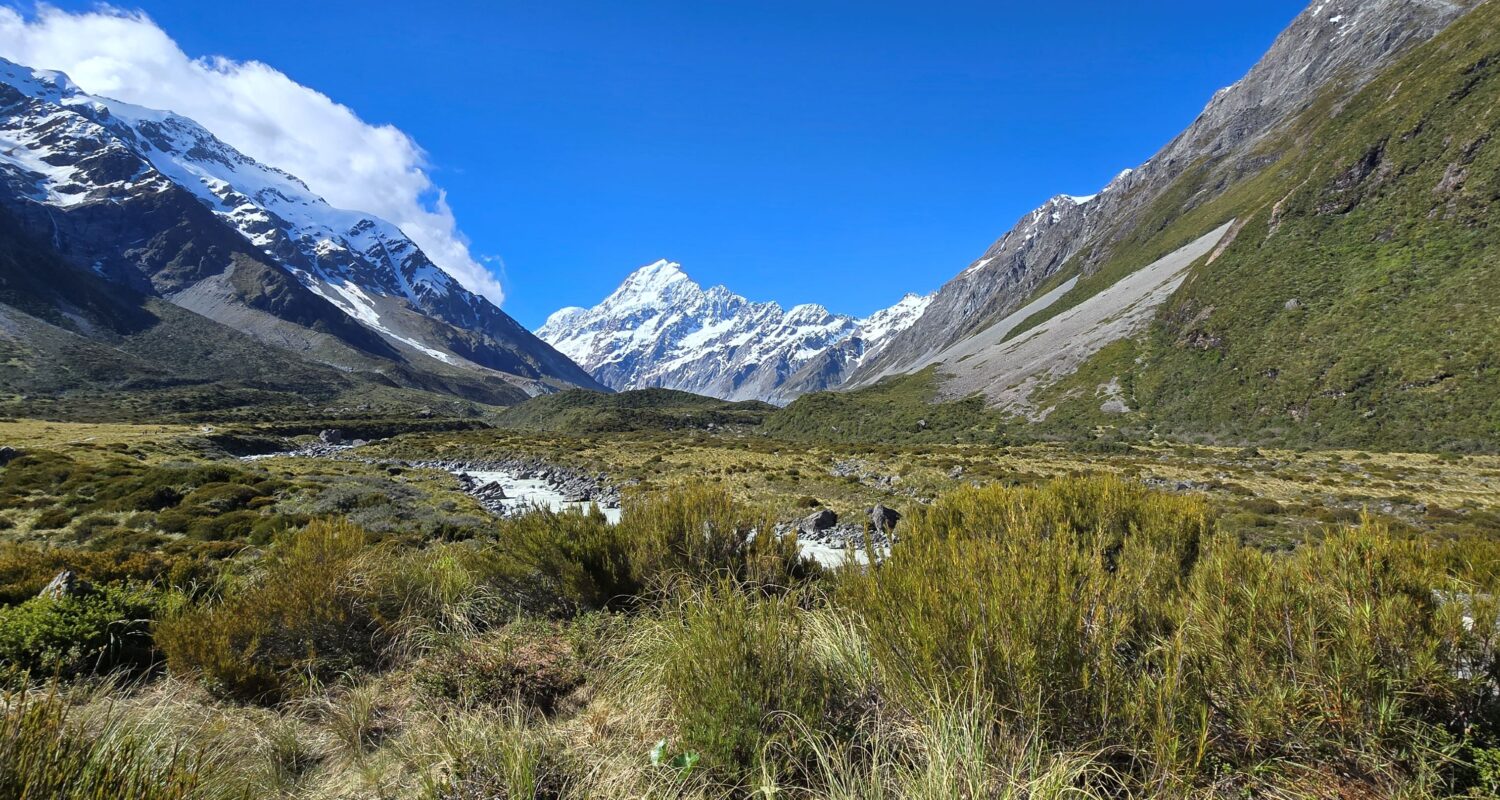
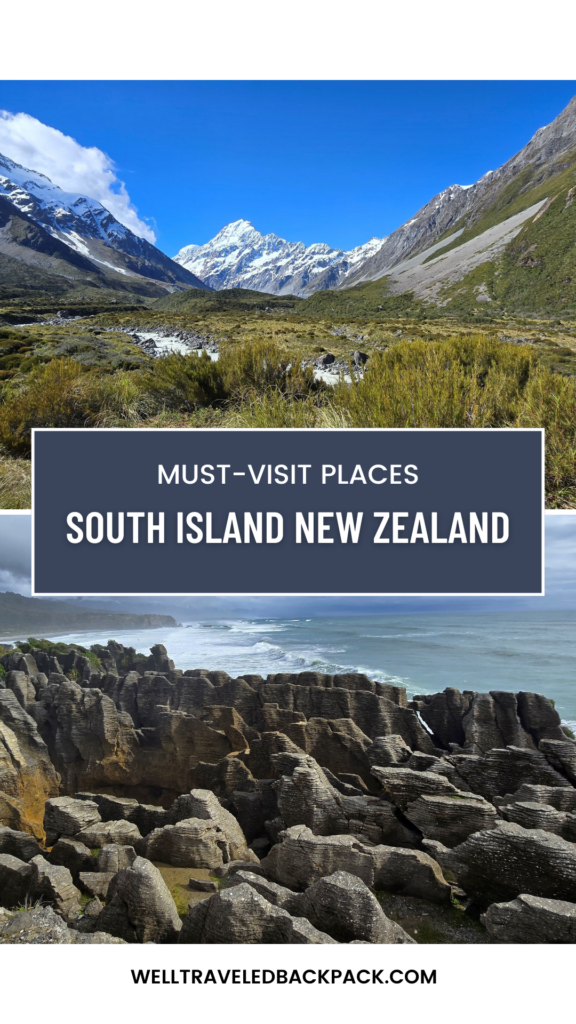
2 thoughts on “Incredible Places to Visit on New Zealand’s South Island”